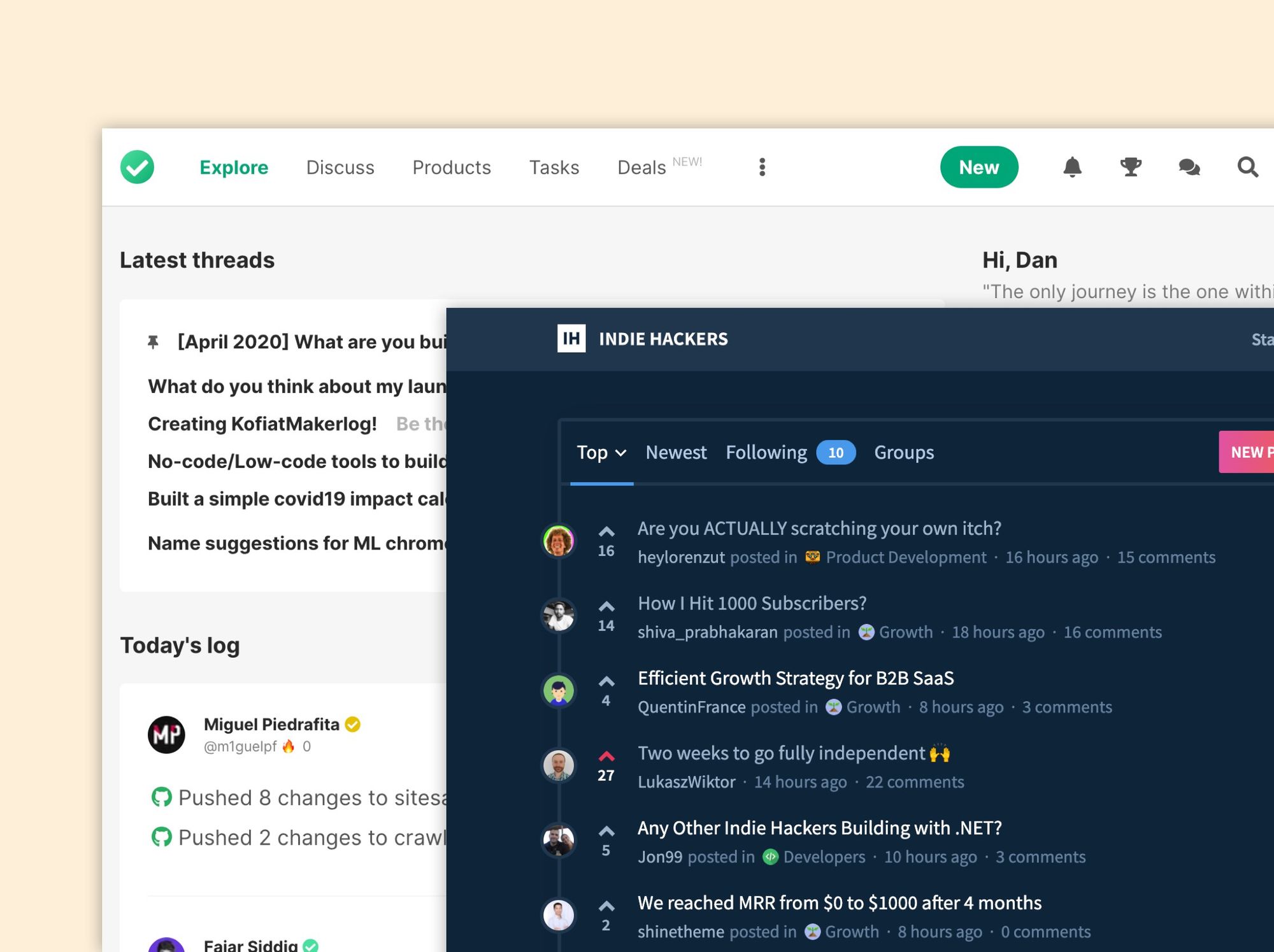Using Indie Hackers and Makerlog to become a better indie maker
How I use maker platforms to become more productive in my own work, and to get inspired by other creators.

I've been building on the web since 2009. For many years, I was “alone”; I read blogs and coding tutorials and a lot of documentation, but I was in isolation. The closest I came to any other coders was at university during my Media Engineering degree, but as our classes spanned the wide landscape of digital media, not many of my peers would have called themselves “coders”.
In recent years, though, a multitude of community platforms have emerged for indie makers, helping to create connections, boost productivity and accountability and forge a large network of independent people making stuff online.
Maker platforms
WIP was the first I remember, back in 2017. Based initially around a simple Telegram group chat, founder Marc Köhlbrugge quickly built an application on which users could log the tasks they were completing and products they were building. It was exciting to join a bustling community of other makers from around the world.
Another platform, Indie Hackers, had already been created in 2016 and in early 2017 it was acquired by payments platform Stripe. It has evolved into a far-ranging site including a popular podcast, community of makers, long-form interviews of entrepreneurs, meetups and a huge lists of products (including revenue numbers).
Product Hunt, originally founded in 2013 as a newsletter surfacing new products, had developed by this time into a site with launches of new products. It was acquired in 2016 by AngelList, and since that community tools have been introduced. Their Makers platform contains discussions, alongside upcoming products and makers checking off tasks.
Finally on my list is Makerlog. A newer entry into the market of maker tools and communities. It initially appeared as a free alternative to WIP but has forged its own community of makers. It contains a similar suite of tools as WIP (tasks, products and discussions).
I've been active on all four platforms at various times, but currently only use Indie Hackers and Makerlog on a regular basis. I find they compliment each other with slightly different feature sets and emphasis on different tools.
Here's what I use the two platforms for...
Indie Hackers
Discussions and learning from others
Indie Hackers has an active community forum full of makers around the world. Discussions are grouped into a range of topics, from Remote Workers to Landing Page Feedback and from Indie Parents to Podcasters. You could easily spend hours browsing the different groups and being part of the conversation. There's a lot happening.
Because of this vibrant community, Indie Hackers is an amazing place to read thoughts from other creators, answer questions with your own experiences, or to ask your own questions. People are typically really helpful and actively share knowledge.
It's a great place for indie makers to learn. With enough sharing and exposure to how other people are dealing with failure or struggles, combined with reading about others' successes, the Indie Hackers community is a brilliant resource.
Logging major project milestones
I've recently started a new project called Cove (more on that soon), and I am planning to use Indie Hackers as a sort of feature release stream. This will create a simple changelog on the Cove page. Indie Hackers is probably not the best place to host a changelog in the future, but this early in a new project it works well and should get some extra exposure from being posted on the platform (new milestones are shown in the right column on the homepage).
Makerlog
Todo list
For me, Makerlog is more about tasks. The "Log" feature lets you add tasks to each of your projects. This either works as a way to record what you've already done (completed tasks) or as a todo list (future tasks). I typically add tasks as I finish them, but if you do add future tasks, you get a nice combined todo list that spans all projects you've added on the platform.
Accountability for progressing side projects
I have built numerous projects over the years but very little of that has been put online. For the times I have posted to the internet, I feel a much bigger sense of accountability.
Once I announce a new project online or post regular information about a project's progress, it increases the urgency for the project. I've had a few ideas spill out into a text note or into a Sketch mockup for it never to move past that point. IN this case, it's as if the project never existed, as it has no external eyes on it. By announcing the start of a project and then continually posting updates online, I'm giving myself a bigger chance to get the thing out the door.
Makerlog is great for this.
Checking what other people are working on
Every task on Makerlog is public and the homepage shows a stream of other makers ticking off or adding tasks. It gives me Twitter circa 2006 vibes.
The homepage is a great source of inspiration to—ironically—get off Makerlog and back into my own tasks 😊 It also creates an amazingly transparent view into what other users are creating all over the world and the projects they're working on. Normally, you may see only a project launch announcement, but seeing the tiny tasks that others are completing to get to that stage is highly motivating.
Subscribe to the newsletter
Join 80+ members and get my new blog posts in your inbox.
Comments
Please subscribe or sign in to join the conversation!